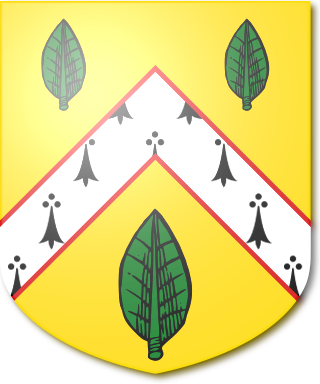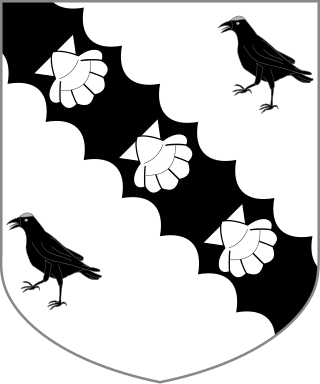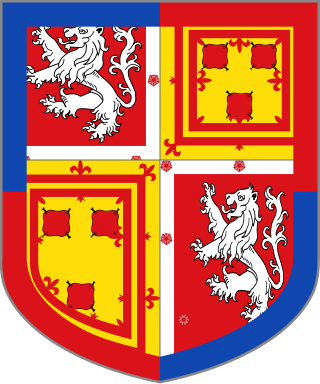
Baron Avebury, of Avebury in the County of Wiltshire, is a title in the Peerage of the United Kingdom. It was created 22 January 1900 for the banker, politician and archaeologist Sir John Lubbock, 4th Baronet. He was succeeded by his eldest son, the second Baron. On his death the titles passed to his nephew, the third Baron. He was the son of Harold Fox Pitt Lubbock, fourth son of the first Baron, who died in 1971. The title then passed to the third Baron's first cousin, the fourth Baron, the son of Maurice Fox Pitt Lubbock, sixth son of the first Baron. The fourth baron was a Liberal Democrat politician and one of the ninety excepted hereditary peers who remained in the House of Lords after the passing of the House of Lords Act 1999. He was succeeded by his son, the fifth Baron, in 2016.

The Cumming-Gordon, later Gordon-Cumming Baronetcy, of Altyre near Forres, is a title in the Baronetage of the United Kingdom. It was created on 27 May 1804 for Alexander Cumming-Gordon, formerly member of parliament for Inverness Burghs. The Cumyn or Cumming family had been settled in Scotland since the 12th century. One member of the family, John II Comyn, Lord of Badenoch, married Eleanor, sister of King John of Scotland. Their son John III Comyn, Lord of Badenoch, known as the "Red Comyn", was a claimant to the Scottish throne through his mother. A later member of the family, Robert Cumming, 13th of Altyre, married Lucy, daughter of Sir Ludovic Gordon of Gordonstoun. Their great-grandson was the first Baronet, who assumed the additional surname of Gordon on succeeding to the Gordon of Gordonstoun estates. The second Baronet sat as Member of Parliament for Elgin Burghs. He changed the family surname from Cumming-Gordon to Gordon-Cumming. The fourth Baronet is best known as a central figure in the Royal Baccarat Scandal.
The Duffbaronetcy, of Halkin in the County of Aberdeen, is a title in the Baronetage of the United Kingdom. It was created on 12 November 1813 for James Duff, British Consul in Cádiz, with remainder to his nephew, William Gordon.

The Austin Baronetcy, of Red Hill in the parish of Castleford in the West Riding of the County of York, is a title in the Baronetage of the United Kingdom. It was created on 16 July 1894 for John Austin, Liberal member of parliament for Osgoldcross.
There have been two baronetcies created for persons with the surname Aykroyd, both in the Baronetage of the United Kingdom for members of the same family.

The Bagge Baronetcy, of Stradsett Hall in the County of Norfolk, is a title in the Baronetage of the United Kingdom. It was created on 13 April 1867 for William Bagge, Conservative Member of Parliament for West Norfolk. The sixth Baronet was Chairman of the West Norfolk District Council between 1976 and 1977.

The Gibson, later Gibson-Carmichael, later Gibson-Craig-Carmichael Baronetcy, of Keirhill in the County of Edinburgh, is a title in the Baronetage of Nova Scotia. It was created on 31 December 1702 for Thomas Gibson, with remainder to his heirs male. The sixth Baronet assumed the additional surname of Carmichael. The eleventh Baronet was a Liberal politician. In 1912, he created Baron Carmichael, of Skirling in the County of Peebles, in the Peerage of the United Kingdom. The barony died in 1926, while he was succeeded in the baronetcy by his kinsman Sir Henry Thomas Gibson-Craig-Carmichael, 5th Baronet, of Riccarton, who became the twelfth Baronet of Keirhill and assumed the additional surname of Carmichael.

The Lowe Baronetcy, of Edgbaston in the City of Birmingham, is a title in the Baronetage of the United Kingdom. It was created on 30 January 1918 for Francis Lowe, Conservative Member of Parliament for Edgbaston from 1898 to 1929.

The Macgregor Baronetcy, of Savile Row in the County of Middlesex, is a title in the Baronetage of the United Kingdom. It was created on 17 March 1828 for Patrick Macgregor, Serjeant-Surgeon to King George IV. Charles Reginald Macgregor (1847–1902), second son of the third Baronet, was a Brigadier-General in the Army.

The Couper Baronetcy is a title in the Baronetage of the United Kingdom. It was created on 23 June 1841 for George Couper. He was a colonel in the Army and fought in the Peninsular War, served as Military Secretary to the Governors General of Canada, Sir James Kempt and Lord Durham, and was Comptroller of the Household and Equerry to Her Royal Highness the Duchess of Kent. The second Baronet was an administrator in India and served as Governor of the North-West Provinces between 1877 and 1882. Another member of the family to gain distinction was James Kempt Couper, second son of the first Baronet. He was a general in the Army.

The Hervey-Bathurst baronetcy, of Lainston in the County of Southampton, is a title in the Baronetage of the United Kingdom. It was created on 7 December 1818 for Felton Hervey-Bathurst, with remainder, failing heirs male of his own, to the heirs male of his father. Hervey-Bathurst was the grandson of the Hon. Felton Hervey, seventh son of John Hervey, 1st Earl of Bristol, and served as an Aide-de-Camp to the Duke of Wellington after the Battle of Waterloo.
The Floyd Baronetcy is a title in the Baronetage of the United Kingdom. It was created on 30 March 1816 for General John Floyd. He was second-in-command at the Battle of Seringapatam in 1799. Floyd's daughter Julia was the wife of Prime Minister Sir Robert Peel, 2nd Baronet. The fifth Baronet was a Brigadier in the 15th/19th Hussars and was Chief-of-Staff of the Eighth Army from 1944 to 1945. Between 1961 and 1968 he served as Lord-Lieutenant of Buckinghamshire. The seventh Baronet was High Sheriff of Rutland in 1968. The fourth baronet's youngest son, Charles Murray Floyd, was a prominent businessman, surveyor and land agent.

The Hamilton baronetcy of Preston, Haddingtonshire was created in the Baronetage of Nova Scotia on 5 November 1673, for William Hamilton, eldest son of Sir Thomas Hamilton, of Preston and Fingalton, by his second wife, Anne Hamilton, of Preston. He married in 1670 Rachel Nicolson of Cockburnpath, but left no male issue, sold his estates, and died c.1690, having left Scotland for the Netherlands. The title passed to his brother Robert, 2nd Baronet. On his death, the title was regarded as dormant, until legal cases in the 19th century saw it revived, and imputed to successors. The name was changed to Stirling-Hamilton in 1889.

The Fletcher, later Boughey Baronetcy, of Newcastle-under-Lyme and of Betley both in the County of Stafford, is a title in the Baronetage of Great Britain. It was created on 24 August 1798 for Thomas Fletcher, of Betley Court, Staffordshire, High Sheriff of Staffordshire in 1783 and 1789 and Deputy Lieutenant of the county. He was the husband of Elizabeth Fenton, granddaughter of George Boughey, of Audley, Staffordshire whose will provided for his great-grandson to inherit the Audley estate.

The Milman Baronetcy, of Levaton-in-Woodland in the County of Devon, is a title in the Baronetage of Great Britain. It was created on 28 November 1800 for Francis Milman, Physician-in-Ordinary to King George III and President of the Royal College of Physicians. The seventh Baronet was a brigadier-general in the British Army.

The Smith, later Smith-Marriott Baronetcy, of Sydling St Nicholas in the County of Dorset, is a title in the Baronetage of Great Britain. It was created on 1 June 1774 for John Smith, High Sheriff of Dorset in 1772. The second Baronet married Elizabeth Anne, daughter of Reverend James Marriott. The fourth Baronet assumed by Royal sign-manual the additional surname of Marriott. The fifth Baronet was High Sheriff of Dorset in 1873.

The Rowley baronetcy, of Hill House in the County of Berkshire, was created in the Baronetage of the United Kingdom on 21 March 1836 for the naval commander Admiral Charles Rowley. He was the fourth son of the 1st Baronet of the 1786 creation.

The Dunbar baronetcy of Northfield was created for William Dunbar of Hempriggs House, Caithness, on 10 April 1700. He had served as a Member of the Scottish Parliament for Caithness constituency.

The Gordon baronetcy of Earlston, Kirkcudbrightshire, was created in the Baronetage of Nova Scotia for William Gordon of Afton, son of William Gordon of Earlston, a Covenanter. He was an army officer, a soldier of fortune under Frederick I of Prussia who took part in Monmouth's Rebellion and the Williamite Wars. He was succeeded by his elder brother Alexander Gordon of Earlston.

The Innes baronetcy, of Balvenie in the County of Banff, was created in the Baronetage of Nova Scotia on 15 January 1628 for Robert Innes, with remainder to heirs male whatsoever.

















